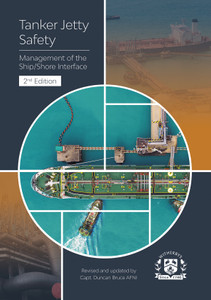
This is an industry guide providing technical recommendations and guidance for the operation and maintenance of single point moorings (SPM).
This industry guide illustrates the types of single point mooring and explains their key structures and functions.
It looks at each stage of SPM operation, including pre-arrival procedures, tanker berthing and mooring, hose connection, cargo transfer, disconnection and departure.
Detailed guidance is provided on inspection and maintenance and there are checklists covering pre-berthing, lubrication and inspection of key structures. There is also guidance on hoses, covering handling, storage, inspection and testing.
This Guide contains technical recommendations and guidance for the operation and maintenance of single point moorings (SPMs). It supersedes the following documents:
• Single Point Mooring Maintenance and Operations Guide (2nd edition, 1995)
• Guidelines for the Handling, Storage, Inspection and Testing of Hoses in the Field (2nd edition, 1995)
• SPM Hose Ancillary Equipment Guide (3rd edition, 1987).
All three publications have been updated to reflect gained experience, revised procedures, current best practices and equipment developments.
This Guide builds on previous recommendations. The following are among the new or significantly changed topics included in this edition:
Section 2 – Design of SPM systems, including preliminary design considerations, site selection and the cargo transfer system including hose systems.
Section 3 – Operation of SPMs now includes:
- – Operating environmental limits
- – Guidance to ensure hoses are lifted safely within tanker crane capacity
- – Guidance and actions regarding ship/shore cargo quantity comparison
- – Qualification and training of personnel, including Mooring Master skills and competence.
Section 4 – Inspection and maintenance now includes time-based schedules based on terminal experience and more detailed inspection procedures for mooring systems. Flushing procedures are also addressed.
Section 5 – This section is devoted to the use of hoses, including:
- – Storage, handling and hose string assembly
- – Hose time in service data from terminals
- – Specific guidance following overpressure
- – Hose inspection and testing
- – Information on marine breakaway couplings.
Appendix A – Contains health, safety, security and environment (HSSE) guidance, referencing Marine Terminal Management and Self Assessment (MTMSA) processes.
Appendix D – Provides information on support vessels and the use of tugs.
This Guide does not intend to cover specialised deep - water moorings, such as steel riser applications. The sections on hoses cover the applications included in the Guide to Manufacturing and Purchasing Hoses for Offshore Moorings (2009).
The Guide contains recommendations on safety, design and good operating practices. However, it is recognised that if more stringent international, national or local regulations apply, those regulations must take precedence.
Section one
Description of single point moorings
1.1 Catenary anchor leg mooring buoys
1.2 Single anchor leg mooring buoy
Section two
Design of single point moorings
2.1 General design considerations
2.2 Site selection and layout
2.3 Mooring load transfer system and load analysis
2.4 Petroleum cargo transfer system
2.5 Single point mooring buoy design
2.6 Hose system design
2.7 Pipeline end manifold
Section three
Operation of single point moorings
3.1 Management of safety, occupational health and security
3.2 Qualifications and training
3.3 Pre-arrival procedures
3.4 Environmental operating limits
3.5 Personnel and equipment transfer between support vessel and tanker
3.6 Tanker berthing and mooring
3.7 Connecting rail hoses
3.8 Operations of tankers in berths
3.9 Cargo transfer
3.10 Disconnecting hoses
3.11 Departure from the single point mooring
Section four
Inspection and maintenance of single point moorings
4.1 Inspection and maintenance principles
4.2 General precautions
4.3 Inspection and maintenance schedules
4.4 Mooring system
4.5 Lifting equipment
4.6 Spares policy
4.7 Line flushing operations
Section five
Handling, storage, testing and inspection of hoses at single point moorings
5.1 Hose lifting and storage
5.2 Hose string assembly and handling
5.3 Hose service life
5.4 Guidance following overpressure and accidents
5.5 Hose inspection and testing requirements
5.6 Inspection and testing of hose strings in-situ
5.7 Testing hoses on shore
5.8 Destructive testing of hoses after retirement
5.9 Hose ancillary equipment
Appendices
Appendix A: The Elements of MTMSA Applied to SPM Management
Appendix B: Calculating the hose lift weight
Appendix C: Forecastle watchman guide
Appendix D: Support facilities for single point moorings
D1 Maintenance support vessels
D1.1 Mooring launches
D1.2 Multipurpose support and maintenance vessels
D2 Use of tugs in operational support
D2.1 Use of tugs for mooring and unmooring
D3 Diving services
D3.1 Terminal organisation and responsibilities for diving
OCIMF
The Oil Companies International Marine Forum (OCIMF) is a voluntary association of oil companies with an interest in the shipment and terminalling of crude oil, oil products, petrochemicals and gas. OCIMF focuses exclusively on preventing harm to people and the environment by promoting best practice in the design, construction and operation of tankers, barges and offshore vessels and their interfaces with terminals. Learn more at:
- Number of Pages:
- 104
- ISBN:
- 9781856096317
- Binding Format:
- Hardback
- Book Height:
- 300 mm
- Book Width:
- 210 mm
- Weight:
- 0.9 kg
- Author:
Oil Companies International Marine Forum
- Published Date:
- October 2015
- Preview:
- Yes
- Publication Date:
- October 2015
 Witherbys.com
Witherbys.com





